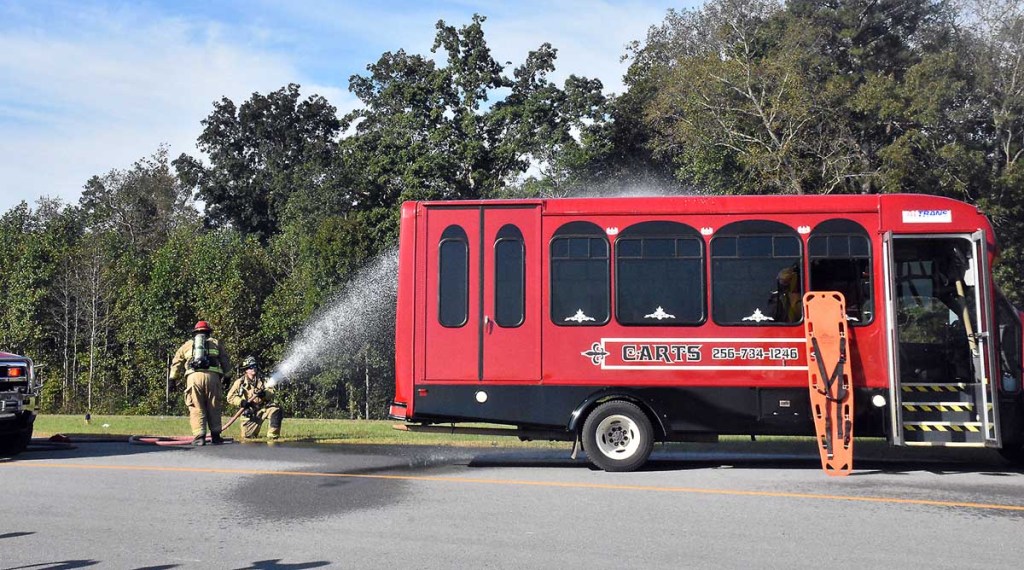An immediate response: Cullman Regional Airport simulates plane crash for training
Published 1:44 pm Friday, October 15, 2021

- A local CARTS bus stands in for a small commercial jet, the 'crashed' aircraft at the center of this week’s emergency training exercise at Cullman Regional Airport.
VINEMONT — At the far end of the airport taxiway, a handful of people are sitting off in the grass, nursing fresh wounds to their arms and legs. A few others are standing around, uninjured but bewildered at what’s just happened. Closer to the wreckage, a pair of teens lie dead. Farther in the grass, there are other bodies, while even more victims — whose status remains unknown — await in the remnants of the small commercial jet in which they’re now trapped passengers.
Thankfully, none of that was real — at least not on Thursday, Oct. 13, when the Cullman Regional Airport brought local response agencies together for a full-scale crash simulation exercise. But having real people and real equipment carry out their roles in a simulated plane crash gave responders a chance to train and prepare for a worst-case plane crash scenario in their own backyard so that, if the unfortunate time comes, they’ll be better equipped to handle the real thing.
“An airplane crash is a lot different than a car accident,” explained airport general manager Ben Harrison. “A lot of times, a car accident is contained. But an air crash is not contained. It’s a large debris field, and it can have a lot of things you don’t normally see with a car accident. In the immediate response, there’s no passenger manifest.
“You don’t know any more about what you’re dealing with than what you see when you first arrive. There can be bodies scattered over a large area. There can be a lot of people walking around in a kind of shock trauma who just don’t know what they’ve been through.”
This week’s exercise marked the first full-scale training measure the airport has staged since Harrison first took on his management role in 2014. It comes at an opportune time: The airport’s main runway is currently a mile-long construction zone, with the asphalt surface ground down ahead of a full resurfacing.
So, the airport took advantage of the downtime to use the adjacent taxiway as a live training site, staging a mock emergency scenario in which a small commercial jet [whose role on Thursday was filled by a local CARTS bus] had crashed and broken apart, killing some of its occupants, injuring others and leaving still others either stuck inside the plane or stranded on the ground outside.
Though it was only an exercise, the emergency response presence felt real. Nearly every local player in Cullman County’s emergency response apparatus was represented at the simulation, including Cullman EMA, volunteer fire departments from Vinemont and West Point, the Cullman Police and fire departments, the Cullman County Sheriff’s Office, Cullman EMS, the Cullman County Coroner, Cullman Ambulance Service, Air Evac Lifeteam 15, Alabama State Troopers and others.
“Our scenario involved a corporate jet that had overshot the runway and broke apart, which gave us a debris field of close to 200 yards,” Harrison explained. “We were trying to simulate as many instances as we could of casualties, whether fatalities or the seriously injured. If you have an aircraft that starts to break apart on landing, you’ll have people in various situations, including people who are thrown out, as well as people still in the fuselage.
“We simulated an aircraft that could have held as many as 20 people, and in our simulation, we ended up having 14 live victims, in various degrees of trauma, and then about five more who were fatalities. We learned a lot of things that you can only learn by actually going through these kinds of motions. It was a good simulation.”
Ideally, the airport aims to stage full-scale, all-hands-on-deck crash response exercises every 3 or 4 years — primarily to ensure that it’s up to date with larger changes in the industry, as well as to keep the training fresh on the minds of everyone who’s involved in local emergency response.
“A lot of things change, over time, with personnel turnover and management,” said Harrison. “It’s important to make sure that it’s something everyone who’s working now has trained on, and we want to thank everyone who participated.
“It’s vital for them to understand what we’re trying to do, because we want everyone involved in a response to be prepared, in the unfortunate event that we ever have to respond to a real emergency at the airport.”


